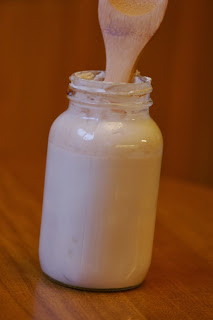One of my favorite memories from Grandpa was waking up in his farmhouse to the smell of his delicious silver dollar sourdough pancakes. He never wrote down the recipe, and I was too young to think of asking him how he made the pancakes. I am several years into the process of trying to duplicate the recipe based on my memories and my family's memories, and each time I make them, I get closer to how Grandpa's pancakes were. I am so honored to have this sourdough from my Grandpa!
I wanted to share with you a few things I have learned while taking care of Grandpa's sourdough for the last few years. Even though it can be a bit time consuming, having your own sourdough starter is worth it. I hope this post will encourage you to get your own sourdough going - or better yet, get a sample from a friend!
When I think of sourdough, the first question I have is, "what is sourdough?" Sourdough, by definition, is "leaven for making bread, consisting of fermenting dough, typically that left over from a previous batch." Wild yeasts and lactobacilli are cultured in a flour and water mixture that is beautiful and alive. These organisms create a symbiotic culture that will grow for years and years, as long as the sourdough is properly fed and taken care of.
Grandpa's sourdough, happily bubbling away. Since I don't have time to feed and use sourdough daily, I keep mine stored in a quart jar stored in the refrigerator.
This is often what my sourdough looks like when I remove it from the refrigerator. If your sourdough looks like this - don't panic! The liquid on top of the sourdough starter is normal - it is called "hooch." Based on my research, some people pour off the hooch and replace it with water, and some people stir it in. I am in the "stir it in" camp, because I feel that a lot of the flavors of the sourdough are in the hooch. So, if you choose to, give the whole sourdough starter jar a good stir and work that hooch back into the starter. Or, pour it off, replace the hooch with water and stir it in.
As you can see, it blends back in nicely with the sourdough. Note the wooden spoon: I never use anything metal on my sourdough - Grandpa always said not to. So, after I stir the sourdough starter, I pour out about a cup - usually what I need to cook with. I set this aside for now.
Here is the sourdough starter I set aside - recipes to follow later!
When my mason jar starts getting too dirty, I pour the remaining sourdough starter into a clean jar. Now, time to feed!
The general rule of thumb is to feed the started with equal parts by weight flour and water. This usually turns out to be approximately 1 cup of water and 3/4 cup of flour. Add the flour and water and stir with the wooden spoon. As you are stirring, note how thick your starter is. Does it need a wee bit more flour? Or a dash of water? Add what the sourdough needs until you feel comfortable with the consistency - some people like very watery starters and some people like them very thick, almost like pancake batter. I like mine in the middle.
Put a plastic lid or plastic wrap over the top of the jar and leave on the counter overnight or for about 8 hours.
The next morning when you take off the lid, you should see lots of little bubbles. This means that your sourdough is alive and working.
Some tips for caring for your sourdough:
- As I wrote earlier, I like to use glass jars with plastic lids to store my sourdough. Those little sourdough crocks are cute, but not really necessary.
- If you think your sourdough is dead because it has been a couple of months since you fed it, don't throw it out right away! Chances are it is still alive. Try to feed it. If it gets bubbly, it is still alive. When this happens to me, I will do a two or three feedings over a few days time to get the sourdough healthy again.
- While you are letting your sourdough rest on the counter, don't screw the plastic lid on tightly - sourdough needs some oxygen, too.
- It is important that everything that touches the sourdough is clean and well rinsed so it has no soap residue.
- I have read you can gradually turn your sourdough into a starter with a different flour, say whole wheat for example. I can't remember where I read it, but the gist of it was to, over many feedings, substitute some whole wheat flour for some of the regular flour, and gradually incorporate a bit more whole wheat flour and less regular flour each time, until, eventually, you are using only whole wheat flour to feed your sourdough. I would recommend taking a portion of your sourdough out to experiment on; just in case it doesn't work you still have a backup!
- Sourdough can be used to make many delicious things: bread, pancakes, sweet breads, English muffins, pizza crust, waffles, popovers, cakes - pretty much anything you can think of! In the next couple of months, I will be sharing my favorite sourdough recipes. Stay tuned!








No comments:
Post a Comment